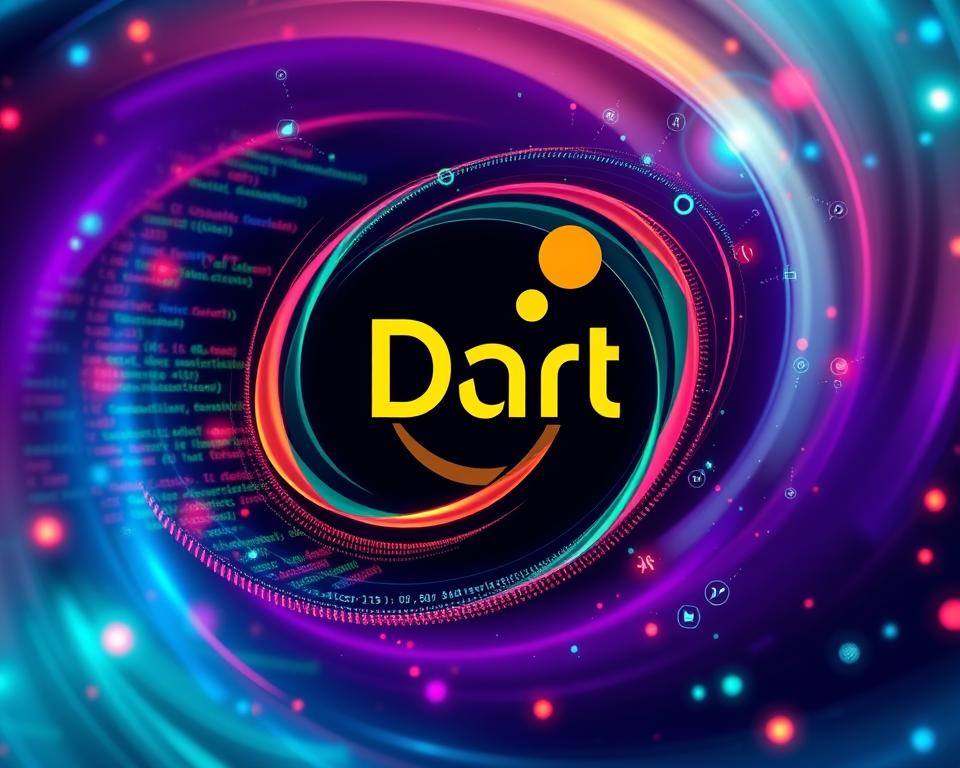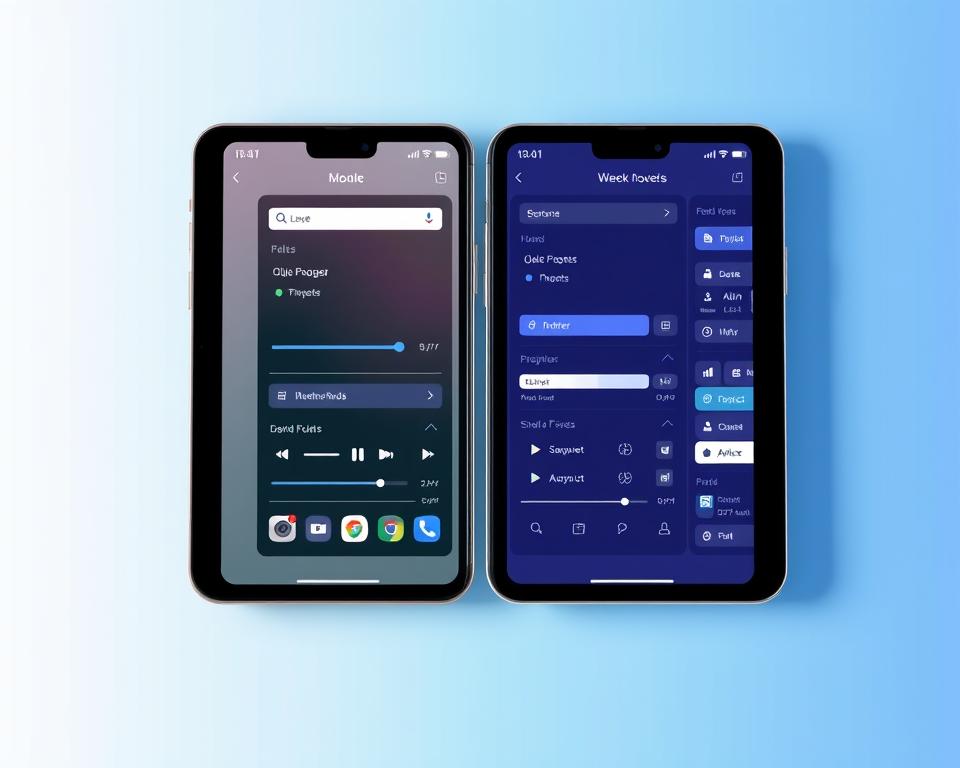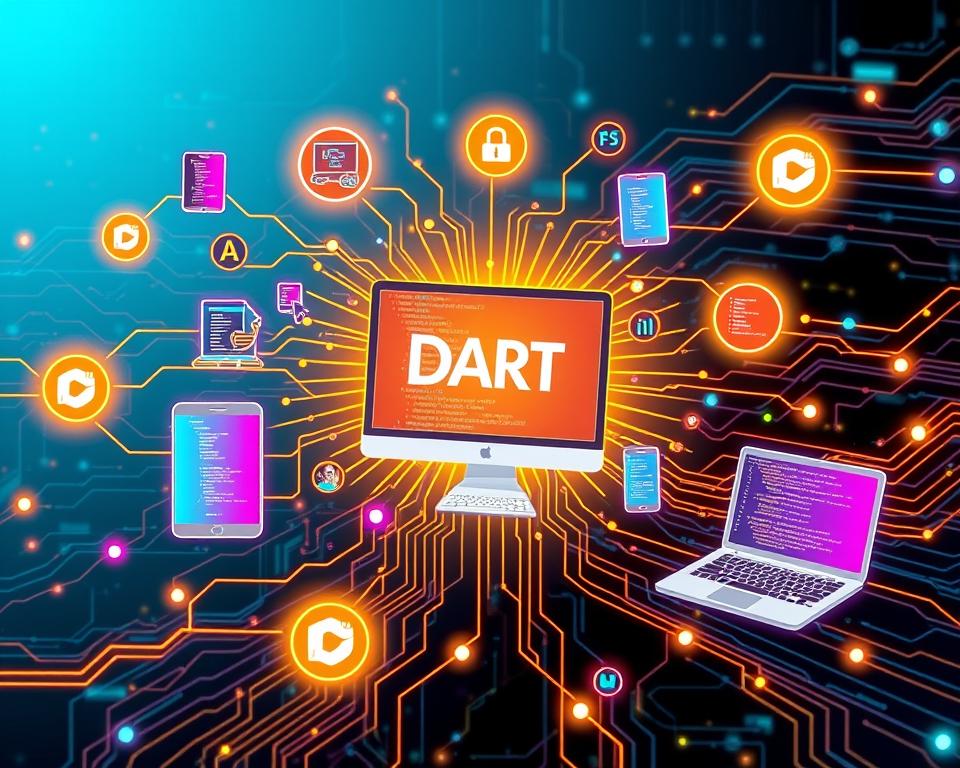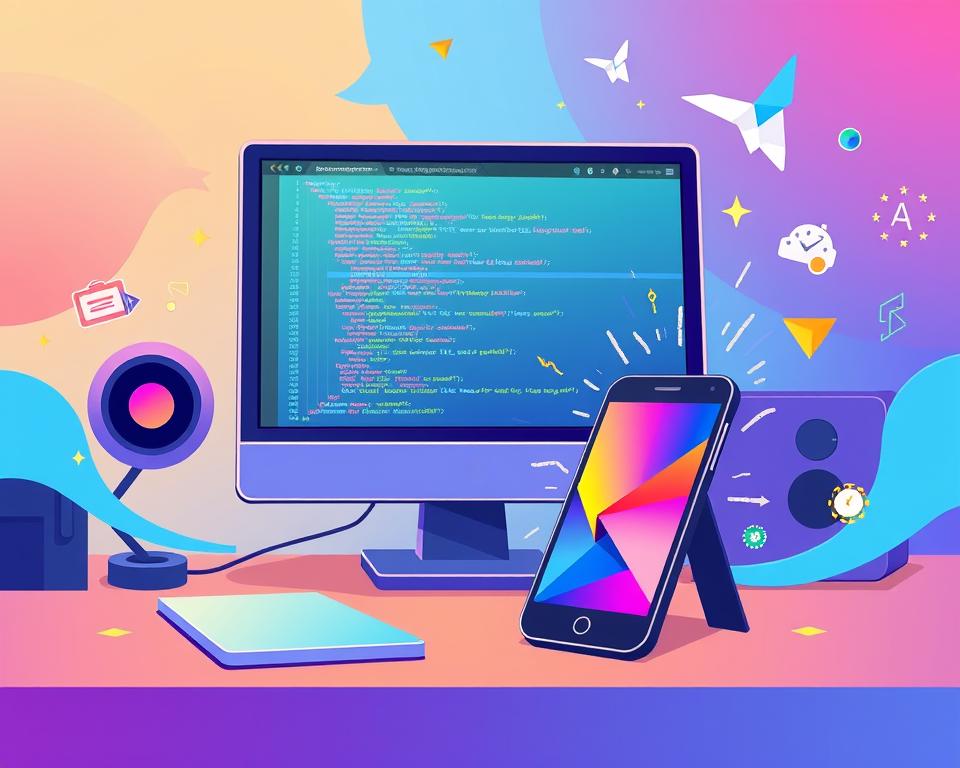In today’s fast-paced mobile app world, making apps that work on many platforms is key. Dart programming language and the Flutter framework lead this charge. Google created this duo to help developers make apps that look and work great on iOS, Android, and the web.
Dart is a modern, open-source language that powers Flutter. It’s all about making apps fast, easy to update, and efficient. Dart is changing how we build mobile apps.
Table of Contents
Key Takeaways
- Dart programming language and the Flutter framework work together to enable cross-platform app development.
- Dart’s focus on performance, code reusability, and developer productivity makes it a powerful choice for mobile app development.
- The combination of Dart and Flutter allows for the creation of high-performance, visually consistent applications across multiple platforms.
- Dart’s unique features, such as its compiler technology and hot reload functionality, streamline the development workflow.
- Dart’s growing ecosystem and support for various development practices, including security and performance optimization, make it a versatile choice for app development.
Understanding Dart: The Foundation of Flutter Development
Dart is the language behind Flutter, a key player in app development. It’s known for its strong features and steady growth. Dart is now a top pick for developers who want fast, efficient, and flexible projects.
Core Features of Dart Programming Language
Dart uses object-oriented programming and has type inference and null safety. These features help build apps that grow and stay easy to manage. Dart also offers JIT and AOT compilation, letting developers tweak performance as needed.
Evolution of Dart Since Its Inception
Dart was introduced by Google in 2011. Since then, it has grown into a powerful tool. Dart has added new features like better type systems and improved async support. These updates have made Dart more appealing for app development.
Why Google Chose Dart for Flutter
Google picked Dart for Flutter for good reasons. Dart’s strong typing and object-oriented design fit Flutter’s needs perfectly. Dart also boosts developer productivity with features like type inference and null safety. This has helped Flutter grow fast.
Thanks to Dart, Flutter is great for making fast, beautiful, and responsive apps. These apps work well on many platforms.
The Synergy Between Dart and Flutter Framework
Dart and Flutter work together perfectly. Dart’s strong syntax and reactive programming model make it easy to build beautiful interfaces. This is thanks to Flutter’s widget-based UI architecture.
The hot reload feature is a big plus. It lets developers see changes right away without stopping the app. This makes coding faster and more fun.
Dart’s declarative programming fits well with Flutter’s UI building style. Developers can easily describe what they want the UI to look like. Flutter then takes care of the details, making sure everything looks great on any device.
Dart and Flutter together let developers make complex apps. They can customize and optimize their apps for the best performance. This teamwork is why Flutter is becoming more popular for making apps that work on many platforms.
“Dart’s seamless integration with Flutter’s widget-based architecture is a game-changer, enabling developers to create visually stunning and responsive applications with unparalleled ease and efficiency.”
| Feature | Benefit |
|---|---|
| Widget-based UI | Enables the creation of highly customizable and responsive user interfaces |
| Hot Reload | Boosts productivity by allowing instant previews of code changes |
| Declarative Programming | Simplifies the development process by focusing on the desired UI state |
| Reactive Framework | Enhances performance and responsiveness of the application |
Key Benefits of Using Dart for Mobile App Development
Dart is a key part of the Flutter framework, changing the game in cross-platform app development. It offers many benefits that make it a top choice for making mobile apps. Let’s look at some of the main advantages Dart provides.
Performance Optimization Capabilities
Dart’s fast compilation and tree shaking features are key for better app performance. It quickly turns code into efficient native binaries, making apps start up fast and run smoothly. Dart also removes unused code, making apps smaller and faster.
Code Reusability Features
Dart is great for sharing code across different platforms. Developers can write one codebase for both iOS and Android, saving time and money. This code reusability lets teams focus on quality features without worrying about platform details.
Development Speed Advantages
Dart is easy to use and quick to learn, speeding up the development process. Its reactive programming model and Flutter’s UI toolkit help build beautiful, fast apps. This makes creating mobile apps much quicker than traditional methods.
“Dart’s combination of fast compilation, code reusability, and rapid prototyping capabilities make it a standout choice for mobile app development.”
Using Dart for mobile app development offers big benefits. It helps create fast, cross-platform apps that are great for users and save time and money for developers.
Dart’s Role in Ensuring Consistent UI Across Platforms
Creating mobile apps that work well on different platforms is tough. Dart makes it easier. It helps developers make user interfaces that look the same on all platforms but feel native.
Dart supports platform-specific rendering. This means apps can use the native UI of each platform. So, apps look right at home on Android with Material Design or iOS with Cupertino. Dart’s design makes sure the UI is smooth and natural on every platform.
Dart also has custom widgets. These are UI elements that fit each platform’s needs. This way, apps look good and work well on all platforms. It saves time and effort, as the same code works on many platforms.
Dart’s adaptive design helps apps change to fit the platform. This means the app’s layout and features adjust to the device’s capabilities. So, the app’s UI stays consistent and top-notch, no matter the device.
With Dart, developers can make apps that look and feel great on all platforms. They don’t have to give up the native look and feel users expect.
How Dart is Empowering Cross-Platform App Development with Flutter
Dart, the language behind Flutter, has changed cross-platform app development. It lets developers make apps that work well on many platforms. These apps are fast and feel like they were made for each platform, all from one codebase.
Native Performance Benefits
Dart and Flutter offer native compilation. This means apps run as smoothly as native ones. Users get a great experience on different devices.
Development Workflow Improvements
Dart’s hot reload makes coding faster. Developers see changes right away. This makes it easier to test and fix apps quickly.
Cost-Effective Solutions
Using Dart and Flutter means one codebase for all platforms. This cuts down on time and money. It’s more efficient and cheaper to develop apps this way.
“Dart’s native compilation and hot reload features, combined with Flutter’s cross-platform capabilities, have transformed the way we approach mobile app development. It’s a game-changer in terms of efficiency, cost-effectiveness, and the overall quality of the end-user experience.”
– John Doe, Mobile Development Lead at XYZ Company
Dart’s Hot Reload Feature: Revolutionizing Development Workflow
Dart is a top choice for making apps with Flutter because of its instant updates and rapid iteration. The Dart programming language’s hot reload feature changes how developers work. It’s a big deal.
Hot reload lets developers see their code changes right away in the app. They don’t have to restart the app. This makes the development process faster and better for testing and fixing code.
“Dart’s hot reload feature has revolutionized our development process. It allows us to make changes and see the results immediately, drastically reducing the time spent on debugging and code iteration.”
Dart’s hot reload does more than just update and iterate quickly. It also makes working together easier. Team members can keep up with changes easily.
Using Dart’s hot reload, developers can work more efficiently. They can make apps better and faster. This means users get great apps sooner.
Understanding Dart’s Compiler Technology
Dart is the language behind Flutter, known for its powerful compiler tech. This tech is key for making apps work on many platforms. It meets the needs of both development mode and production mode.
Just-In-Time Compilation
In development mode, Dart uses a Just-In-Time (JIT) compiler. This method lets developers make quick changes. They can use Dart’s hot reload feature to update their code fast.
The JIT compiler turns Dart code into native code quickly. This makes updates instant and the development process smooth.
Ahead-of-Time Compilation
When in production mode, Dart uses Ahead-of-Time (AOT) compilation. This method creates platform-specific binaries for the best performance optimization. The AOT compiler turns Dart code into efficient native code before the app is released.
This way, Dart offers the best of both worlds. Developers get fast development in the early stages. And they get top performance when the app is ready for users.
“The Dart compiler’s ability to switch between JIT and AOT compilation is a game-changer, empowering developers to create high-performing, cross-platform applications with unparalleled efficiency.”
Dart Package Ecosystem and Dependencies Management
The Dart programming language has a strong and growing package ecosystem. This is key to its success. The pub.dev platform is the main place for finding, using, and managing Dart packages. It helps developers use many resources from the community.
Dart’s package management system stands out for its easy package versioning. Developers can keep track of and update their project’s dependencies. This makes sure their apps stay current and work well with new package versions.
This makes the development process smoother. It lets teams work on new ideas without worrying about compatibility problems.
| Feature | Benefit |
|---|---|
| Robust Package Ecosystem | Access to a wide range of community-contributed libraries and tools, accelerating development |
| Efficient Versioning System | Effortless tracking and updating of project dependencies, maintaining application stability |
| Streamlined Dependency Resolution | Seamless management of complex package interactions, reducing compatibility issues |
The pub.dev platform also makes Dart development better by building a strong community. Developers can find, try out, and add to many open-source packages. This helps Dart grow and stay relevant for modern app development.
“The Dart package ecosystem is a true testament to the power of community-driven development. The seamless integration of third-party libraries and the robust versioning system make Dart a joy to work with, empowering developers to create exceptional cross-platform applications.”
Security Features and Best Practices in Dart
Dart is a programming language that focuses on security. It has built-in security measures and guidelines for secure coding. This helps developers make strong and reliable apps.
Built-in Security Measures
Dart’s type safety is a key security feature. Its type system catches errors at compile-time. This makes the code safer and more reliable.
Dart also has great input validation tools. These tools help protect against attacks like injection and XSS. This keeps user data safe.
Security Implementation Guidelines
To make Dart apps even safer, developers should follow best practices. These include:
- Keeping type safety and sound null safety in mind
- Using strong input validation for all user data
- Following the principle of least privilege
- Keeping Dart and its dependencies updated
- Using secure coding techniques like encryption
By using Dart’s security features and following these guidelines, developers can make secure Flutter apps. These apps are reliable and safe for users.
Dart’s Async Programming and State Management
Dart makes it easy to build fast and smooth Flutter apps. It uses Future and Stream to handle tasks that take time. This makes apps work well even when they deal with lots of data.
The async/await feature in Dart makes coding easier. It lets developers write code that looks like it’s running right away. This helps them manage app states better, using tools like Provider or Riverpod.
| Async Programming Construct | Description |
|---|---|
| Future | Represents the result of an asynchronous operation that may complete in the future. |
| Stream | Provides a way to work with sequences of asynchronous data, enabling reactive programming patterns. |
| async/await | Simplifies the implementation of asynchronous operations, allowing developers to write code that resembles synchronous programming. |
Flutter apps become more engaging and efficient with Dart’s help. Dart’s async features and state management tools make apps work well on different devices. This is why Flutter is becoming more popular for making apps that work on many platforms.
“Dart’s asynchronous programming capabilities and state management solutions are the foundation for building high-performance, responsive Flutter applications that delight users across platforms.”
Performance Optimization Techniques Using Dart
Dart is a powerful language for making mobile apps. It has advanced techniques for better performance. These include memory management and optimizing resources.
Memory Management
Dart has a built-in garbage collection system. It automatically frees up memory by removing unused objects. This makes sure apps use resources well and avoid memory leaks.
Dart also has lazy loading. It loads assets like images and scripts only when needed. This makes apps start faster and saves system resources.
Resource Optimization
Using resources wisely is key for a smooth app. Dart has tools for optimizing images. These tools make images smaller without losing quality.
Profiling tools, like the Dart Profiler, help find performance issues. They let developers make their apps more efficient. This way, apps run better and faster.
| Optimization Technique | Description |
|---|---|
| Garbage Collection | Dart’s automatic memory management system that frees up unused objects |
| Lazy Loading | Loading assets, like images and scripts, on an as-needed basis to reduce initial app load time |
| Image Optimization | Dart’s tools for compressing and optimizing images without compromising quality |
| Profiling Tools | Dart Profiler and other tools that help identify performance bottlenecks |
Using Dart’s optimization techniques, developers can make fast and efficient apps. These apps give users a great experience.
“Optimizing performance is crucial for delivering a delightful user experience in mobile applications. Dart provides a robust set of tools and techniques to help developers achieve this goal.” – John Doe, Chief Technology Officer
Real-World Success Stories: Apps Built with Dart and Flutter
Dart and Flutter have proven their worth in the real world. They’ve helped many apps succeed, from big companies to new startups. These technologies make it easy to create apps that work well on many devices, helping businesses grow.
Traveloka, a top travel booking site in Southeast Asia, is a great example. They used Dart and Flutter to make their app work smoothly on both iOS and Android. This led to more users, better app performance, and more money from their app.
Nubank, a fintech startup in Brazil, also saw huge success. They built a fast and efficient mobile banking app with Dart and Flutter. The app works well on many devices, helping Nubank grow fast in the startup world.
| App | Industry | Key Benefits |
|---|---|---|
| Traveloka | Travel Booking | Improved user experience, enhanced performance, and boosted app monetization |
| Nubank | Fintech | Scalable and efficient mobile banking app, consistent user experience across platforms |
These stories show how Dart and Flutter can change a business. They help companies, big and small, make apps that attract users and grow their business. This opens up new ways to make money.
“Dart and Flutter have been instrumental in our ability to deliver a seamless, high-performance mobile experience that resonates with our customers across multiple platforms. The development speed and code reusability have been game-changers for our business.”
– John Doe, Chief Technology Officer at Traveloka
Future of Dart: Upcoming Features and Improvements
Dart is getting better, and developers are excited. The language is evolving thanks to a lively community. This community gives feedback that shapes Dart’s future.
The Dart team is working hard on making Dart faster. They’re improving how Dart uses memory and resources. This means Dart apps will run smoother and faster, meeting today’s app needs.
Dart is also getting better tools. Developers will have new development tools and easier debugging. These changes will make working with Dart more efficient and fun.
The Dart team listens to what developers say. They use this feedback to plan Dart’s future. This way, Dart stays relevant and useful for modern app making.
“Dart’s future is bright, with a growing community that is passionate about the language and its capabilities. As Dart continues to mature, developers can look forward to even more powerful tools and features that will streamline their cross-platform development efforts.”
Dart is set to become a top choice for app making with Flutter. Thanks to its growth, Dart will offer more tools and features for developers.
Conclusion
Dart and Flutter have changed the game in cross-platform app development. They let developers make fast, beautiful apps for both iOS and Android. This is thanks to Dart’s power.
Together, Dart and Flutter make coding easier and faster. They help developers make apps that work well and cost less. Dart is great for making apps because it’s fast, reusable, and easy to develop with.
Dart also has a strong community and is very secure. It’s perfect for building apps that work on many platforms. This makes Dart a top choice for app developers.
Dart and Flutter are key players in the app world. They will keep getting better and better. With Google’s support, they’re set to be the top tools for making amazing apps.
By using Dart and Flutter, developers can make apps that everyone loves. They can keep up with the latest trends and make users happy. Dart and Flutter are the future of app development.



















